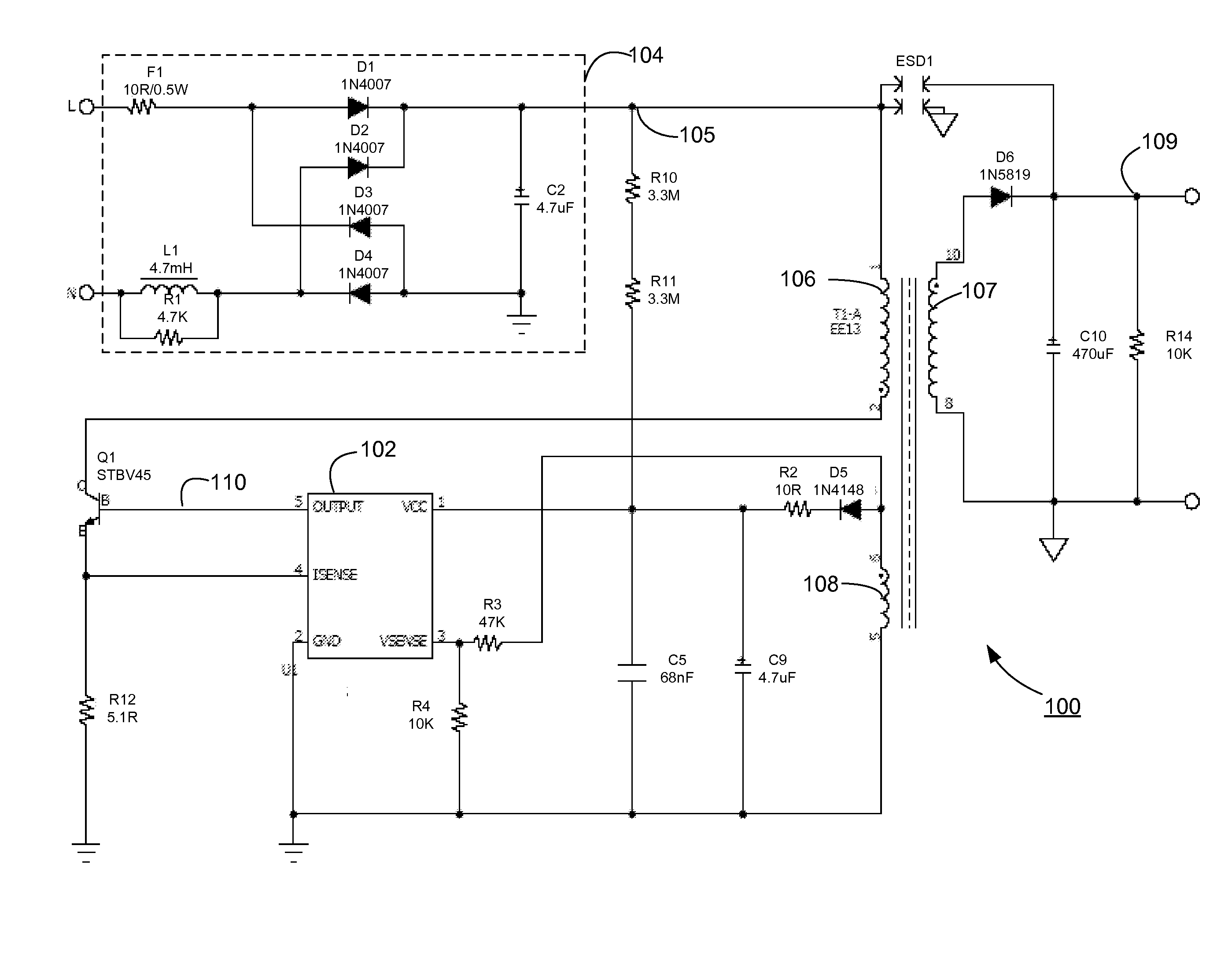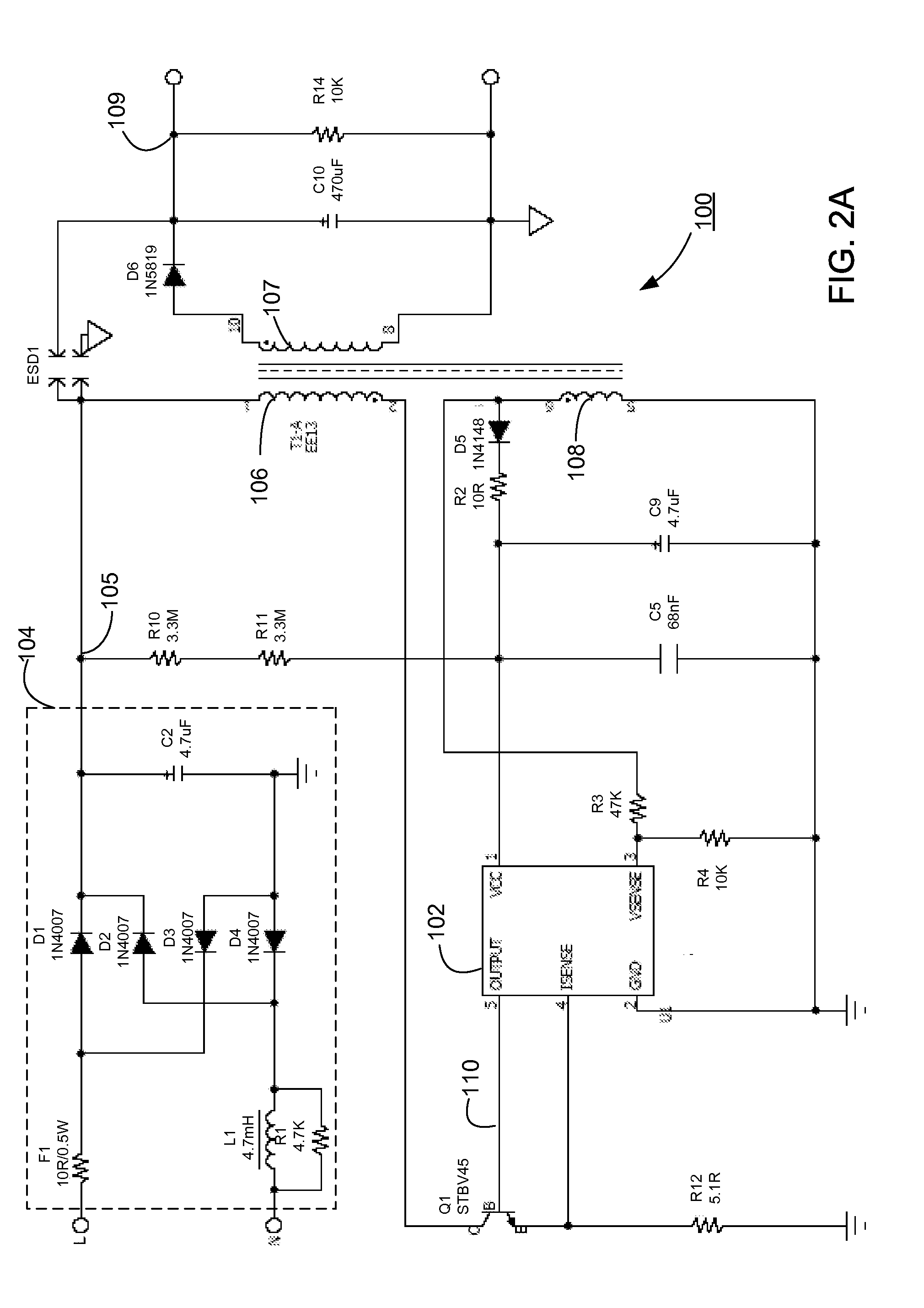Adaptive multi-mode digital control improving light-load efficiency in switching power converters
Active Publication Date: 2010-07-01
DIALOG SEMICONDUCTOR
View PDF5 Cites 72 Cited by
- Summary
- Abstract
- Description
- Claims
- Application Information
AI Technical Summary
Benefits of technology
[0013]Embodiments include adaptive multi-mode digital control approaches that improve the switching power converter light-load efficiency without causing performance issues such as large audible noises or excessive voltage ripple or degraded dynamic load response. The switching power converter includes a switch that electrically couples or decouples a load to or from a power source. A switch controller coupled to the switch controls on-times and off-times of the switch. The switch controller includes digital logic for generating a pulse signal that controls on-times and off-times of the switch. Th
Problems solved by technology
Conversely, conduction loss plays a greater role as the load is increased.
Such low setting of threshold level I3, however, does not help improve the efficiency at 25% load.
Therefore, conventional PWM/PFM control with low threshold level I3 does not help improve the overall average efficiency, for example, as defined by world wide energy standards such as US-EPA 2.0 and EU-CoC.
With conventional control approaches, however, PWM mode to PFM mode transition at higher load conditions suffer from serious performance problems such as excessive voltage ripples caused by unsmooth transition between PWM mode and PFM mode.
The power converters operati
Method used
the structure of the environmentally friendly knitted fabric provided by the present invention; figure 2 Flow chart of the yarn wrapping machine for environmentally friendly knitted fabrics and storage devices; image 3 Is the parameter map of the yarn covering machine
View moreImage
Smart Image Click on the blue labels to locate them in the text.
Smart ImageViewing Examples
Examples
Experimental program
Comparison scheme
Effect test
 Login to View More
Login to View More PUM
 Login to View More
Login to View More Abstract
Adaptive multi-mode digital control schemes that improve the light-load efficiency (and thus the overall average efficiency) in switch-mode power converters without causing performance issues such as audible noises or excessive voltage ripples. Embodiments include a switch-mode power converter that reduces current in the power converter using a second pulse-width-modulation (PWM) mode before reaching switching frequencies that generate audible noises. As the load across the output of the power converter is reduced, the power converter transitions from a first PWM mode in high load conditions to a first pulse-frequency-modulation (PFM) mode, then to a second PWM mode, and finally to a second PFM mode. During the second PFM mode, the switching frequency is dropped to audible frequency levels. Current in the power converter, however, is reduced in the second PWM mode before transitioning to the second PFM mode. Therefore, the power converter produces less or no audible noise in light load conditions where the switching frequency drops to audible frequency levels, while achieving high efficiency across varying load conditions.
Description
CROSS-REFERENCE TO RELATED APPLICATION[0001]This application claims priority under 35 U.S.C. §119(e) to co-pending U.S. Provisional Patent Application No. 61 / 141,059 entitled “Adaptive Multi-Mode Digital Control Improving Light-Load Efficiency in Switching Power Converters,” filed on Dec. 29, 2008, which is incorporated by reference herein in its entirety.BACKGROUND OF THE INVENTION[0002]1. Field of the Invention[0003]The present invention relates to controlling a switching power converter in more than one operation mode to increase the efficiency of the power converter at light load conditions.[0004]2. Description of the Related Arts[0005]Efficiency of a switching power converter is governed largely by two types of loss: switching loss and conduction loss. In most switching power converters, switching loss plays a greater role as the load across the output of the power converter is decreased. Conversely, conduction loss plays a greater role as the load is increased. In order to red...
Claims
the structure of the environmentally friendly knitted fabric provided by the present invention; figure 2 Flow chart of the yarn wrapping machine for environmentally friendly knitted fabrics and storage devices; image 3 Is the parameter map of the yarn covering machine
Login to View More Application Information
Patent Timeline
 Login to View More
Login to View More IPC IPC(8): G05F1/10
CPCH02M3/157H02M2001/0032Y02B70/16Y02B70/10H02M1/0032G05F1/66G05F1/00
Inventor LI, YONGSEIM, CARRIEZHENG, JUNJIEKESTERSON, JOHN W.YAN, LIANGPOON, CLARITASHI, FUQIANG
Owner DIALOG SEMICONDUCTOR
Features
- R&D
- Intellectual Property
- Life Sciences
- Materials
- Tech Scout
Why Patsnap Eureka
- Unparalleled Data Quality
- Higher Quality Content
- 60% Fewer Hallucinations
Social media
Patsnap Eureka Blog
Learn More Browse by: Latest US Patents, China's latest patents, Technical Efficacy Thesaurus, Application Domain, Technology Topic, Popular Technical Reports.
© 2025 PatSnap. All rights reserved.Legal|Privacy policy|Modern Slavery Act Transparency Statement|Sitemap|About US| Contact US: help@patsnap.com



